The best thermal cameras let you see things invisible to the human eye. They reveal poor insulation, fire risks, and even dampness. And they come in many shapes and sizes. So we’ve selected the best thermal camera across styles and price ranges.
Our top pick is a great all-rounder. The TOPDON TC002 has an impressive temperature range, excellent refresh rate and sensitivity, and is compact and simple to use.
Our Top 3 Choices for The Best Thermal Camera
FLIR ONE Gen 3 Thermal Camera
FLIR ONE Gen 3 Thermal Camera
Shop Offers
×
FLIR ONE Gen 3 Thermal Camera Deals
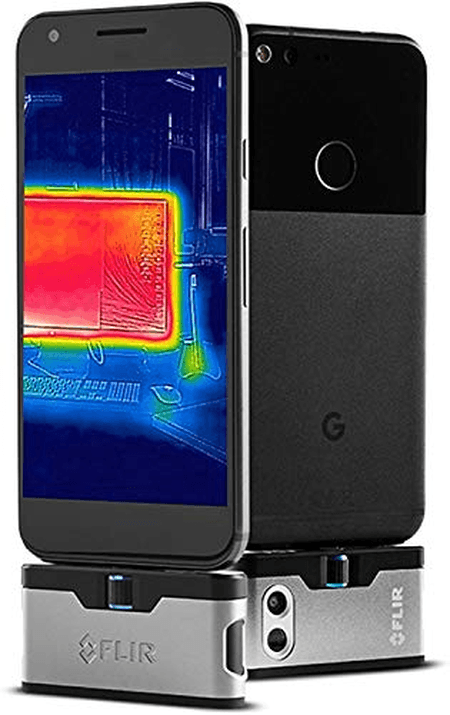
|
(second hand)
Check Price
|
(second hand)
|
Check Price
|
Buy Now!
|
If you buy a product through one of our referral links we will earn a commission (without costing you anything).
Prices last updated on .
As an Amazon Associate, I earn from qualifying purchases. Product prices and availability are accurate as of the date/time indicated and are subject to change. Any price and availability information displayed on Amazon at the time of purchase will apply to the purchase of this product.
Unavailable
TOPDON TC002 Thermal Imaging Camera
TOPDON TC002 Thermal Imaging Camera
Shop Offers
×
TOPDON TC002 Thermal Imaging Camera Deals
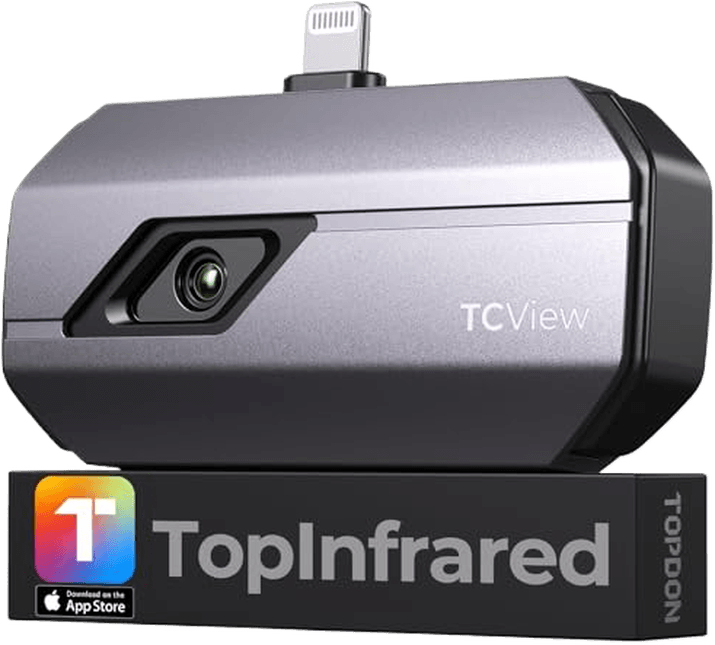
|
(second hand)
Check Price
|
(second hand)
|
Check Price
|
Buy Now!
|
If you buy a product through one of our referral links we will earn a commission (without costing you anything).
Prices last updated on .
As an Amazon Associate, I earn from qualifying purchases. Product prices and availability are accurate as of the date/time indicated and are subject to change. Any price and availability information displayed on Amazon at the time of purchase will apply to the purchase of this product.
Unavailable
FLIR C3-X Thermal Camera
Shop Offers
×
FLIR C3-X Thermal Camera Deals
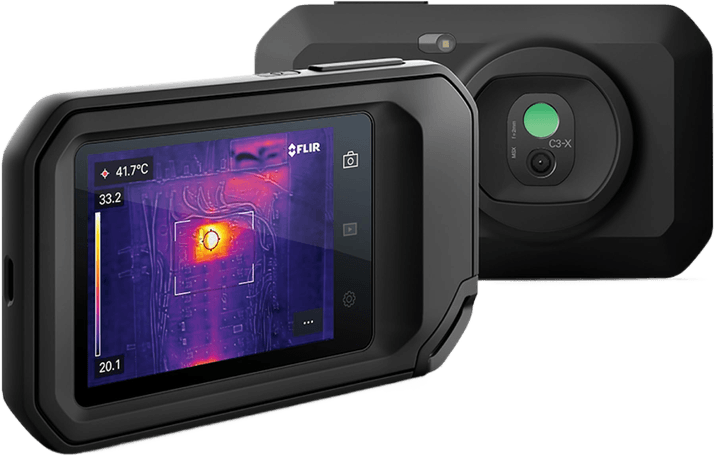
|
(second hand)
Check Price
|
(second hand)
|
Check Price
|
Buy Now!
|
If you buy a product through one of our referral links we will earn a commission (without costing you anything).
Prices last updated on .
As an Amazon Associate, I earn from qualifying purchases. Product prices and availability are accurate as of the date/time indicated and are subject to change. Any price and availability information displayed on Amazon at the time of purchase will apply to the purchase of this product.
Unavailable
What Is the Best Thermal Camera?
We’re going to look at our choices in detail. But first, here’s a summary of our recommended thermal cameras for you.
Our Top Choice
FLIR ONE Gen 3 Thermal Camera
FLIR ONE Gen 3 Thermal Camera
- Available for iOS and Android
- Micro USB and USB-C for Android
- MSX imaging technology
- Records video and stills to the cloud
- Works with most phone cases
Shop Offers
×
FLIR ONE Gen 3 Thermal Camera Deals

|
(second hand)
Check Price
|
(second hand)
|
Check Price
|
Buy Now!
|
If you buy a product through one of our referral links we will earn a commission (without costing you anything).
Prices last updated on .
As an Amazon Associate, I earn from qualifying purchases. Product prices and availability are accurate as of the date/time indicated and are subject to change. Any price and availability information displayed on Amazon at the time of purchase will apply to the purchase of this product.
Unavailable
Best for Reaching Awkward Places
TOPDON TC002 Thermal Imaging Camera
TOPDON TC002 Thermal Imaging Camera
- Available for Lightning and USB-C
- Impressive 40 mK sensitivity
- Extension cable for remote imaging
- 25 Hz refresh rate
- 256 x 192 pixels resolution
Shop Offers
×
TOPDON TC002 Thermal Imaging Camera Deals

|
(second hand)
Check Price
|
(second hand)
|
Check Price
|
Buy Now!
|
If you buy a product through one of our referral links we will earn a commission (without costing you anything).
Prices last updated on .
As an Amazon Associate, I earn from qualifying purchases. Product prices and availability are accurate as of the date/time indicated and are subject to change. Any price and availability information displayed on Amazon at the time of purchase will apply to the purchase of this product.
Unavailable
Best Standalone Camera
FLIR C3-X Thermal Camera
FLIR C3-X Thermal Camera
- MSX technology
- 5 MP visible light sensor
- Built-in LED light
- Rugged construction
- IP54 weather protection
Shop Offers
×
FLIR C3-X Thermal Camera Deals

|
(second hand)
Check Price
|
(second hand)
|
Check Price
|
Buy Now!
|
If you buy a product through one of our referral links we will earn a commission (without costing you anything).
Prices last updated on .
As an Amazon Associate, I earn from qualifying purchases. Product prices and availability are accurate as of the date/time indicated and are subject to change. Any price and availability information displayed on Amazon at the time of purchase will apply to the purchase of this product.
Unavailable
Best Budget Phone Camera
PerfectPrime IR202 Thermal Image Camera
PerfectPrime IR202 Thermal Image Camera
- Available for Android and iOS
- Plug-and-play simplicity
- 15 Hz refresh rate
- Small and compact
- Perfect for occasional use
Shop Offers
×
PerfectPrime IR202 Thermal Image Camera Deals
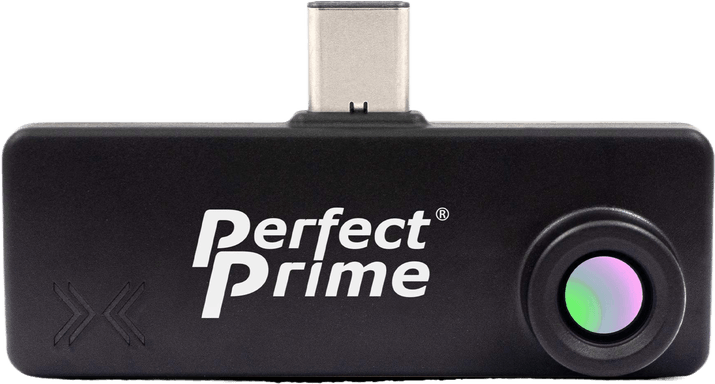
|
(second hand)
Check Price
|
(second hand)
|
Check Price
|
Buy Now!
|
If you buy a product through one of our referral links we will earn a commission (without costing you anything).
Prices last updated on .
As an Amazon Associate, I earn from qualifying purchases. Product prices and availability are accurate as of the date/time indicated and are subject to change. Any price and availability information displayed on Amazon at the time of purchase will apply to the purchase of this product.
Unavailable
Highest Resolution Plug-In
Seek Thermal CompactPRO Thermal Imaging Camera
Seek Thermal CompactPRO Thermal Imaging Camera
- Android and iOS versions
- USB-C and Micro USB for Android
- High 320 x 240 pixel resolution
- Neat and compact
- Available in several versions
Shop Offers
×
Seek Thermal CompactPRO Thermal Imaging Camera Deals
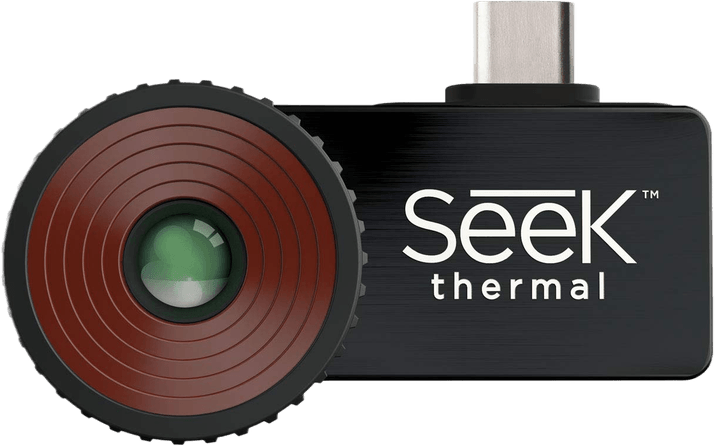
|
(second hand)
Check Price
|
(second hand)
|
Check Price
|
Buy Now!
|
If you buy a product through one of our referral links we will earn a commission (without costing you anything).
Prices last updated on .
As an Amazon Associate, I earn from qualifying purchases. Product prices and availability are accurate as of the date/time indicated and are subject to change. Any price and availability information displayed on Amazon at the time of purchase will apply to the purchase of this product.
Unavailable
Best Budget Pistol-Grip
FLIR TG267 Thermal Camera
FLIR TG267 Thermal Camera
- MSX and laser for accurate aiming
- Up to 5 hours of battery life
- Tripod mount
- 4 GB internal storage
- IP54-rated for weather protection
Shop Offers
×
FLIR TG267 Thermal Camera Deals
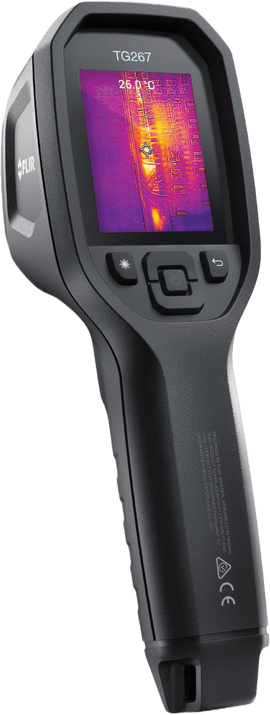
|
(second hand)
Check Price
|
(second hand)
|
Check Price
|
Buy Now!
|
If you buy a product through one of our referral links we will earn a commission (without costing you anything).
Prices last updated on .
As an Amazon Associate, I earn from qualifying purchases. Product prices and availability are accurate as of the date/time indicated and are subject to change. Any price and availability information displayed on Amazon at the time of purchase will apply to the purchase of this product.
Unavailable
Best Value for High Temperature Sensitivity
HTI-Xintai HTI-19 Thermal Camera
HTI-Xintai HTI-19 Thermal Camera
- Up to 500 C temperature sensitivity
- High resolution of 320 x 240 pixels
- 50 mK sensitivity
- 3 GB internal storage
- Parallax error compensation
Shop Offers
×
HTI-Xintai HTI-19 Thermal Camera Deals
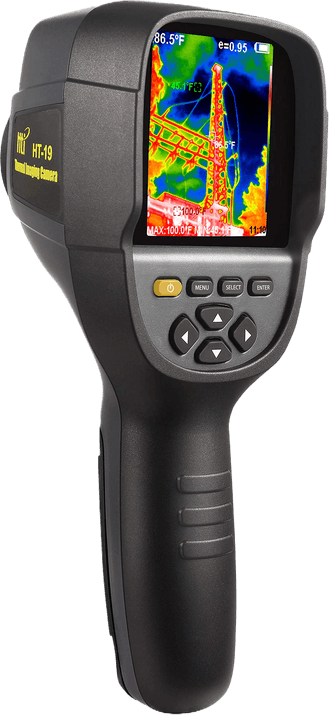
|
(second hand)
Check Price
|
(second hand)
|
Check Price
|
Buy Now!
|
If you buy a product through one of our referral links we will earn a commission (without costing you anything).
Prices last updated on .
As an Amazon Associate, I earn from qualifying purchases. Product prices and availability are accurate as of the date/time indicated and are subject to change. Any price and availability information displayed on Amazon at the time of purchase will apply to the purchase of this product.
Unavailable
Best for Streaming Images
Seek Thermal ShotPRO Thermal Image Camera
Seek Thermal ShotPRO Thermal Image Camera
- Identifies temperature differences up to 1000 feet away
- Detects both heat and cold spots
- Capture images and videos in the included app
- Easy-to-use and intuitive interface
- Lightweight and compact design
Shop Offers
×
Seek Thermal ShotPRO Thermal Image Camera Deals
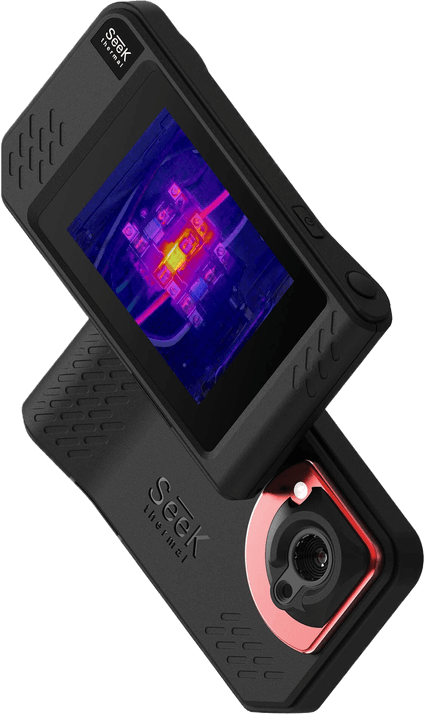
|
(second hand)
Check Price
|
(second hand)
|
Check Price
|
Buy Now!
|
If you buy a product through one of our referral links we will earn a commission (without costing you anything).
Prices last updated on .
As an Amazon Associate, I earn from qualifying purchases. Product prices and availability are accurate as of the date/time indicated and are subject to change. Any price and availability information displayed on Amazon at the time of purchase will apply to the purchase of this product.
Unavailable
Highest Temperature Range
FLIR E8-XT Infrared Camera
FLIR E8-XT Infrared Camera
- Quickly and easily diagnose problems
- Accurate non-contact temperature measurement
- Detects hidden problems
- 8,500 temperature points for detailed images
- High resolution imagery
Shop Offers
×
FLIR E8-XT Infrared Camera Deals
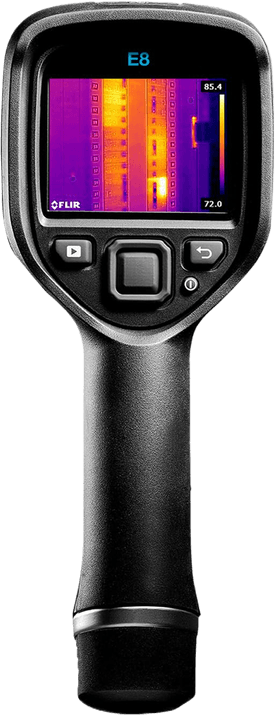
|
(second hand)
Check Price
|
(second hand)
|
Check Price
|
Buy Now!
|
If you buy a product through one of our referral links we will earn a commission (without costing you anything).
Prices last updated on .
As an Amazon Associate, I earn from qualifying purchases. Product prices and availability are accurate as of the date/time indicated and are subject to change. Any price and availability information displayed on Amazon at the time of purchase will apply to the purchase of this product.
Unavailable
9 Best Thermal Cameras
Now let’s look in more detail at our recommended thermal cameras. Jump to our buying guide at the end if you need some help sorting out features to consider. Or it may answer some questions you may have.
1. FLIR ONE Gen 3 Thermal Camera
Shop Offers
×
FLIR ONE Gen 3 Thermal Camera Deals

|
(second hand)
Check Price
|
(second hand)
|
Check Price
|
Buy Now!
|
If you buy a product through one of our referral links we will earn a commission (without costing you anything).
Prices last updated on .
As an Amazon Associate, I earn from qualifying purchases. Product prices and availability are accurate as of the date/time indicated and are subject to change. Any price and availability information displayed on Amazon at the time of purchase will apply to the purchase of this product.
Unavailable

Shop Offers
×
FLIR ONE Gen 3 Thermal Camera Deals

|
(second hand)
Check Price
|
(second hand)
|
Check Price
|
Buy Now!
|
If you buy a product through one of our referral links we will earn a commission (without costing you anything).
Prices last updated on .
As an Amazon Associate, I earn from qualifying purchases. Product prices and availability are accurate as of the date/time indicated and are subject to change. Any price and availability information displayed on Amazon at the time of purchase will apply to the purchase of this product.
Unavailable
|
Brand |
Brand
FLIR
|
|
Resolution |
Resolution
80 x 60 pixels
|
|
Sensitivity Range |
Sensitivity Range
-4 to 248 F (-20 to 120 C)
|
|
Thermal Sensitivity |
Thermal Sensitivity
150 mK
|
|
Key Features |
Key Features
MSX technology for quality, enhanced imaging, iPhone and Android USB-C versions
|
|
Best For |
Best For
Finding electric, insulation, or water problems around the house
|
FLIR ONE Gen 3 Thermal Camera
FLIR is a pretty dominant brand in the thermal imaging camera sector. There is a wide range of FLIR cameras that cater to many budgets. And this is one of their cheaper ones.
Like the PerfectPrime, the FLIR ONE Gen 3 attaches an IR camera to the bottom of your phone. But it has its own battery that needs to be charged. So this could limit long sessions.
FLIR supplies an adapter to connect to Android handsets equipped with USB-C ports. Rather handily, you can adjust the connector. This means it should cope with a wide range of cases. So you don’t have to remove the case before using the thermal camera.
FLIR is a popular manufacturer because of its MSX (Multi-Spectral Dynamic Imaging) technology. Many thermal imaging devices allow you to see either thermal or visible light images.
Often cameras blend them to show more precisely where the hotspots (or coldspots) are. Remember, the thermal image is a much lower resolution than the visible light image. So having the detail from the visible light camera is a bonus.
MSX technology is slightly different. It takes the visible light images and uses them to emboss the thermal imaging. This can be very useful if you’re looking for a heat signature in a tangle of wires or pipes.
What the Gen 3 doesn’t do is allow infrared or visual images to be shown on their own. But this is their entry-level device, so the features are limited.
The FLIR app allows you to record stills and videos and organize the files. If you’re one of several users in an organization, there is a cloud option to store and access everyone’s images.
2. TOPDON TC002 Thermal Imaging Camera
Shop Offers
×
TOPDON TC002 Thermal Imaging Camera Deals

|
(second hand)
Check Price
|
(second hand)
|
Check Price
|
Buy Now!
|
If you buy a product through one of our referral links we will earn a commission (without costing you anything).
Prices last updated on .
As an Amazon Associate, I earn from qualifying purchases. Product prices and availability are accurate as of the date/time indicated and are subject to change. Any price and availability information displayed on Amazon at the time of purchase will apply to the purchase of this product.
Unavailable

Shop Offers
×
TOPDON TC002 Thermal Imaging Camera Deals

|
(second hand)
Check Price
|
(second hand)
|
Check Price
|
Buy Now!
|
If you buy a product through one of our referral links we will earn a commission (without costing you anything).
Prices last updated on .
As an Amazon Associate, I earn from qualifying purchases. Product prices and availability are accurate as of the date/time indicated and are subject to change. Any price and availability information displayed on Amazon at the time of purchase will apply to the purchase of this product.
Unavailable
|
Brand |
Brand
TOPDON
|
|
Resolution |
Resolution
256 x 192 pixels
|
|
Sensitivity Range |
Sensitivity Range
-4 to 1022 F (-20 to 550 C)
|
|
Thermal Sensitivity |
Thermal Sensitivity
40 mK
|
|
Key Features |
Key Features
25 Hz frame rate, available for USB-C Android and iPhone
|
|
Best For |
Best For
Reaching awkward places with the extension cable
|
TOPDON TC002 Thermal Imaging Camera
Amazon.co.uk
$209.99 $229.65
The TOPDON TC002 is an impressive thermal imaging camera. First of all, it’s neat and compact. It attaches to the bottom of your phone via Lightning or USB-C. And it comes in a handy zippered pouch for safekeeping.
There is also a short extension cable. So if you need to get into a space that’s too big for your phone, you can use the TC002 remotely. It’s very handy.
The TC002 can be plugged in facing towards or away from you, which is handy. When you connect it, the phone will automatically ask you if you want to launch the Topinfrared app.
The app is very to use. You can choose a live view of what you see and take a photo or video of it. You can also choose to monitor a spot, line, or plane.
What I love about the TOPDON TC002 is that it is simple to use for a complete beginner. And it is also a very sophisticated piece of kit for the advanced user. I actually keep mine either in my camera backpack or take it with me when I’m traveling.
3. FLIR C3-X Compact Thermal Camera
Shop Offers
×
FLIR C3-X Thermal Camera Deals

|
(second hand)
Check Price
|
(second hand)
|
Check Price
|
Buy Now!
|
If you buy a product through one of our referral links we will earn a commission (without costing you anything).
Prices last updated on .
As an Amazon Associate, I earn from qualifying purchases. Product prices and availability are accurate as of the date/time indicated and are subject to change. Any price and availability information displayed on Amazon at the time of purchase will apply to the purchase of this product.
Unavailable

Shop Offers
×
FLIR C3-X Thermal Camera Deals

|
(second hand)
Check Price
|
(second hand)
|
Check Price
|
Buy Now!
|
If you buy a product through one of our referral links we will earn a commission (without costing you anything).
Prices last updated on .
As an Amazon Associate, I earn from qualifying purchases. Product prices and availability are accurate as of the date/time indicated and are subject to change. Any price and availability information displayed on Amazon at the time of purchase will apply to the purchase of this product.
Unavailable
|
Brand |
Brand
FLIR
|
|
Resolution |
Resolution
128 x 96 pixels
|
|
Sensitivity Range |
Sensitivity Range
-4 to 572 F (-20 to 300 C)
|
|
Thermal Sensitivity |
Thermal Sensitivity
70 mK
|
|
Key Features |
Key Features
MSX technology, LED light, and robust case
|
|
Best For |
Best For
Demanding everyday use
|
The FLIR C3-X comes in a robust case designed to survive two-meter drops. The touchscreen display is 640 x 480 pixels. It’s low by phone and camera standards but adequate for the task. And there is an LED light to help the f/1.1 aperture on the visible-light camera in poor light.
This thermal camera offers good flexibility for viewing images. You can view what the IR sensors see or what the normal camera sees. Also, you can see the MSX or a picture-in-picture IR image on top of the visual image. The refresh rate is 9 Hz.
The FLIR C3-X uses a rechargeable battery. It should give you about 2 hours of use in normal circumstances. And as with all FLIR IR cameras, the software is key to making the most of the thermal images. It also allows easy sharing.
This rugged, no-nonsense thermal imaging device meets most needs very well. I haven’t included a separate entry for the FLIR C5. It is very similar to look at but has an upgraded sensor.
It also has a higher top limit of temperature detection of 752 F (400 C) and a better resolution of 160 x 120 pixels. This is a 50% increase. Both have IP54 weather ratings.
4. PerfectPrime IR202 Infrared Thermal Camera
Shop Offers
×
PerfectPrime IR202 Thermal Image Camera Deals

|
(second hand)
Check Price
|
(second hand)
|
Check Price
|
Buy Now!
|
If you buy a product through one of our referral links we will earn a commission (without costing you anything).
Prices last updated on .
As an Amazon Associate, I earn from qualifying purchases. Product prices and availability are accurate as of the date/time indicated and are subject to change. Any price and availability information displayed on Amazon at the time of purchase will apply to the purchase of this product.
Unavailable

Shop Offers
×
PerfectPrime IR202 Thermal Image Camera Deals

|
(second hand)
Check Price
|
(second hand)
|
Check Price
|
Buy Now!
|
If you buy a product through one of our referral links we will earn a commission (without costing you anything).
Prices last updated on .
As an Amazon Associate, I earn from qualifying purchases. Product prices and availability are accurate as of the date/time indicated and are subject to change. Any price and availability information displayed on Amazon at the time of purchase will apply to the purchase of this product.
Unavailable
|
Brand |
Brand
PerfectPrime
|
|
Resolution |
Resolution
80 x 60 pixels
|
|
Sensitivity Range |
Sensitivity Range
-40 to 752 F (-40 to 400 C)
|
|
Thermal Sensitivity |
Thermal Sensitivity
150 mK
|
|
Key Features |
Key Features
15 Hz frame rate, available for USB-C Android and iPhone
|
|
Best For |
Best For
Keeping in the toolbox for occasional use
|
PerfectPrime IR202 Thermal Image Camera
The PerfectPrime IR202 is our best budget thermal imaging camera. And it makes you feel like James Bond. It attaches to the bottom of your Android smartphone via the USB-C socket or the Lightning port if you have an iPhone.
And it uses your phone’s battery and screen. So you don’t have to worry about the screen resolution. The idea is quite simple. Plug the infrared (IR) camera into the phone. Then use the phone’s processing power, battery, and screen to do the rest.
This is a very small unit. It adds a shade over an inch (2.5 cm) to the length of your phone. You can easily carry it in a bag or even in your pocket. And it comes with a pouch to protect it.
The refresh rate of the image is 15 Hz or 15 frames per second (fps). This is adequate if you’re looking for heat leaking from your house. If you want to identify prey on a hunt, then look elsewhere. A moving image with this low frame rate is tiring on the eyes.
It’s unlikely a daily building inspector would buy this. Not all industry people believe the product’s temperature range and sensitivity claims.
But it’s worth considering this thermal imaging camera if you have an occasional need. Or maybe you just fancy having a nifty thermal gadget to add to your collection.
There is another version available. It’s a pricier, higher-resolution thermal scanning camera.
5. Seek Thermal CompactPRO Thermal Imaging Camera
Shop Offers
×
Seek Thermal CompactPRO Thermal Imaging Camera Deals

|
(second hand)
Check Price
|
(second hand)
|
Check Price
|
Buy Now!
|
If you buy a product through one of our referral links we will earn a commission (without costing you anything).
Prices last updated on .
As an Amazon Associate, I earn from qualifying purchases. Product prices and availability are accurate as of the date/time indicated and are subject to change. Any price and availability information displayed on Amazon at the time of purchase will apply to the purchase of this product.
Unavailable

Shop Offers
×
Seek Thermal CompactPRO Thermal Imaging Camera Deals

|
(second hand)
Check Price
|
(second hand)
|
Check Price
|
Buy Now!
|
If you buy a product through one of our referral links we will earn a commission (without costing you anything).
Prices last updated on .
As an Amazon Associate, I earn from qualifying purchases. Product prices and availability are accurate as of the date/time indicated and are subject to change. Any price and availability information displayed on Amazon at the time of purchase will apply to the purchase of this product.
Unavailable
|
Brand |
Brand
Seek Thermal
|
|
Resolution |
Resolution
320 x 240 pixels
|
|
Sensitivity Range |
Sensitivity Range
-40 to 626 F (-40 to 330 C)
|
|
Thermal Sensitivity |
Thermal Sensitivity
70 mK
|
|
Key Features |
Key Features
15 Hz frame rate, available for Micro USB, USB-C, and iPhone
|
|
Best For |
Best For
Multi-function indoor and outdoor use
|
Seek Thermal CompactPRO Thermal Imaging Camera
Another thermal imaging phone attachment is the Seek Thermal CompactPRO. It helps you see everything from building problems to animals in the dark.
But be aware that the frame rate of the Seek Thermal CompactPRO could land you in trouble if you try to leave the US with it! There are restrictions on IR devices above certain specifications. This is put in place in case they’re used for military purposes.
So this is not an international travel option. Consider other options if your needs are linked to finding the best thermal imaging camera for travel.
The refresh rate of 15 Hz is higher than the FLIR ONE. And the IR image resolution is significantly higher. But you have to consider that there is no visual image blending or overlay. So the 320 x 240 resolution is the highest you get. This could be a deal breaker for you.
The CompactPRO is available in several different models. So it’s a consideration if you might change your phone soon. It also comes in cheaper Compact and Compact XR versions.
6. FLIR TG267 Thermal Camera
Shop Offers
×
FLIR TG267 Thermal Camera Deals

|
(second hand)
Check Price
|
(second hand)
|
Check Price
|
Buy Now!
|
If you buy a product through one of our referral links we will earn a commission (without costing you anything).
Prices last updated on .
As an Amazon Associate, I earn from qualifying purchases. Product prices and availability are accurate as of the date/time indicated and are subject to change. Any price and availability information displayed on Amazon at the time of purchase will apply to the purchase of this product.
Unavailable

Shop Offers
×
FLIR TG267 Thermal Camera Deals

|
(second hand)
Check Price
|
(second hand)
|
Check Price
|
Buy Now!
|
If you buy a product through one of our referral links we will earn a commission (without costing you anything).
Prices last updated on .
As an Amazon Associate, I earn from qualifying purchases. Product prices and availability are accurate as of the date/time indicated and are subject to change. Any price and availability information displayed on Amazon at the time of purchase will apply to the purchase of this product.
Unavailable
|
Brand |
Brand
FLIR
|
|
Resolution |
Resolution
160 x 120 pixels
|
|
Sensitivity Range |
Sensitivity Range
-13 to 716 F (-25 to 380 C)
|
|
Thermal Sensitivity |
Thermal Sensitivity
70 mK
|
|
Key Features |
Key Features
MSX, IP54 rating, laser aim indicator, 4 GB storage
|
|
Best For |
Best For
Using one-handed or with a tripod
|
FLIR TG267 Thermal Camera
This is another FLIR and another different body shape. The FLIR TG267 resembles a barcode scanner. The screen sits atop a pistol grip.
It has an IP54 rating and drop resistance. And it is easy to use with one hand and has a laser to show you where it’s pointing. The target market for these IR cameras is likely mechanics.
The pistol grip allows for a bigger battery, giving you up to five hours of use. MSX imaging is there, of course. But you are limited to the IR image or the MSX.
There is no non-IR image available. But you can record visual images with temperatures overlaid.
There’s 4 GB of onboard storage. There is also a tripod mount, which is useful to have. There’s no Wi-Fi, so you must rely on the USB cable. And you also use this to charge the camera, which takes four hours to 90%.
If you need to use a thermal camera easily with one hand, the TG267 is well worth a look.
7. Hti-Xintai HTI-19 Infrared Thermal Camera
Shop Offers
×
HTI-Xintai HTI-19 Thermal Camera Deals

|
(second hand)
Check Price
|
(second hand)
|
Check Price
|
Buy Now!
|
If you buy a product through one of our referral links we will earn a commission (without costing you anything).
Prices last updated on .
As an Amazon Associate, I earn from qualifying purchases. Product prices and availability are accurate as of the date/time indicated and are subject to change. Any price and availability information displayed on Amazon at the time of purchase will apply to the purchase of this product.
Unavailable

Shop Offers
×
HTI-Xintai HTI-19 Thermal Camera Deals

|
(second hand)
Check Price
|
(second hand)
|
Check Price
|
Buy Now!
|
If you buy a product through one of our referral links we will earn a commission (without costing you anything).
Prices last updated on .
As an Amazon Associate, I earn from qualifying purchases. Product prices and availability are accurate as of the date/time indicated and are subject to change. Any price and availability information displayed on Amazon at the time of purchase will apply to the purchase of this product.
Unavailable
|
Brand |
Brand
Hti-Xintai
|
|
Resolution |
Resolution
320 x 240 pixels
|
|
Sensitivity Range |
Sensitivity Range
-4 to 932 F (-20 to 500 C)
|
|
Thermal Sensitivity |
Thermal Sensitivity
50 mK
|
|
Key Features |
Key Features
High maximum temperature and 3 GB memory
|
|
Best For |
Best For
Users needing a higher temperature range
|
HTI-Xintai HTI-19 Thermal Camera
The Hti HT19 is another pistol-grip camera for thermal imaging. It has 3 GB of onboard memory and a rechargeable battery. It should give you about three hours of recording thermal images.
The conventional camera records as usual. The refresh rate is 9 fps.
The menus allow you to adjust the position of the images. This is because, like any similar camera, there is some parallax error. This varies according to the distance from the subject.
The 50 mK sensitivity is impressive. So is the high maximum temperature of 932 F (500 C). This might be a major selling point for you at this price point.
In other ways, there are some shortcomings. There’s no tripod mount. There is no wireless option, so you must transfer images via USB. And there’s no target laser for easy target pointing.
The 320 x 240 resolution is a plus. And combined with the high maximum temperature range, it’s worth a look.
8. Seek Thermal ShotPRO Handheld Thermal Imaging Camera
Shop Offers
×
Seek Thermal ShotPRO Thermal Image Camera Deals

|
(second hand)
Check Price
|
(second hand)
|
Check Price
|
Buy Now!
|
If you buy a product through one of our referral links we will earn a commission (without costing you anything).
Prices last updated on .
As an Amazon Associate, I earn from qualifying purchases. Product prices and availability are accurate as of the date/time indicated and are subject to change. Any price and availability information displayed on Amazon at the time of purchase will apply to the purchase of this product.
Unavailable

Shop Offers
×
Seek Thermal ShotPRO Thermal Image Camera Deals

|
(second hand)
Check Price
|
(second hand)
|
Check Price
|
Buy Now!
|
If you buy a product through one of our referral links we will earn a commission (without costing you anything).
Prices last updated on .
As an Amazon Associate, I earn from qualifying purchases. Product prices and availability are accurate as of the date/time indicated and are subject to change. Any price and availability information displayed on Amazon at the time of purchase will apply to the purchase of this product.
Unavailable
|
Brand |
Brand
Seek Thermal
|
|
Resolution |
Resolution
320 x 240 pixels
|
|
Sensitivity Range |
Sensitivity Range
-40 to 626 F (-40 to 330 C)
|
|
Thermal Sensitivity |
Thermal Sensitivity
70 mK
|
|
Key Features |
Key Features
Live sharing of images via Wi-Fi, 4 GB storage
|
|
Best For |
Best For
Sharing hotspot images with others
|
Seek Thermal ShotPRO Thermal Image Camera
With 4 GB internal storage and 4-hour battery life, the Seek Thermal ShotPro is aimed at serious users. It also has the Thermal company’s equivalent of FLIR’s MSX.
Thermal calls it SeekFusion Technology, and it offers similar performance. An on-screen slider lets you adjust the blend of available and IR light in any image.
This thermal imaging device is shaped more like a compact camera than other infrared ones. It has a camera-like handgrip on the right-hand side. And it has a tripod mount for stable fixing.
If you need to share the images you are seeing, you can stream from the ShotPro via its built-in Wi-Fi. And it’s rated at IP54 for bad weather use. So it’s a good choice for tradespeople who need a reliable thermal imaging camera.
9. FLIR E8-XT Infrared Camera
Shop Offers
×
FLIR E8-XT Infrared Camera Deals

|
(second hand)
Check Price
|
(second hand)
|
Check Price
|
Buy Now!
|
If you buy a product through one of our referral links we will earn a commission (without costing you anything).
Prices last updated on .
As an Amazon Associate, I earn from qualifying purchases. Product prices and availability are accurate as of the date/time indicated and are subject to change. Any price and availability information displayed on Amazon at the time of purchase will apply to the purchase of this product.
Unavailable

Shop Offers
×
FLIR E8-XT Infrared Camera Deals

|
(second hand)
Check Price
|
(second hand)
|
Check Price
|
Buy Now!
|
If you buy a product through one of our referral links we will earn a commission (without costing you anything).
Prices last updated on .
As an Amazon Associate, I earn from qualifying purchases. Product prices and availability are accurate as of the date/time indicated and are subject to change. Any price and availability information displayed on Amazon at the time of purchase will apply to the purchase of this product.
Unavailable
|
Brand |
Brand
FLIR
|
|
Resolution |
Resolution
320 x 240 pixels
|
|
Sensitivity Range |
Sensitivity Range
-4 to 1022 F (-20 to 550 C)
|
|
Thermal Sensitivity |
Thermal Sensitivity
50 mK
|
|
Key Features |
Key Features
Very high maximum temperature sensitivity
|
|
Best For |
Best For
Professionals needing its high heat capability
|
FLIR E8-XT Infrared Camera
The FLIR E8-XT is our final FLIR and our final camera. And it’s another doubling of cost. Even priced over $3,000, this is not in the heavy-hitter league of thermal imaging cameras. The most notable feature of the FLIR E8-XT is the top end of its sensitivity.
At 1022 F (550 C), this is clearly aimed at professionals who need to work with very high temperatures. People in this market need specific features. And they are willing to pay for what they need because it is essential for their work.
Perhaps the most interesting thing about this camera? How little it differs from the cheaper ones. That’s not to say it isn’t worth the money. It is to say how well-equipped even some of the cheapest thermal imaging cameras are.
Buying Guide for Thermal Cameras
Here are some answers to a few FAQs. We hope they help you in your buying decision.
How Do I Choose a Thermal Imaging Camera?
Thermal cameras are used to detect and visualize thermal radiation. This is emitted by all objects based on their temperature. Thermal cameras are often used in industrial and engineering applications. But they have become more popular for personal use in recent years.
Thermal cameras come in a variety of shapes and sizes. There are small handheld cameras to large-format ones you can mount on drones.
There are many factors you should consider when purchasing a thermal camera. These include the resolution, spectral range, and image processing capabilities.
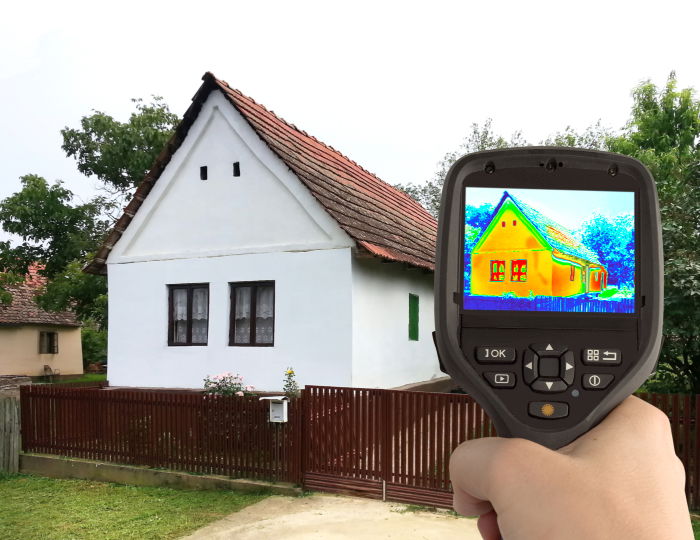
How Does a Thermal Imaging Camera Work?
Light is one tiny segment of the electromagnetic spectrum. Imagine visible light as one octave on a piano. And the whole electromagnetic spectrum would stretch from Earth to the Sun. Thermal imaging cameras work by “seeing” the infrared (IR) section of that spectrum.
Heat produces IR. And a thermal imaging camera uses this infrared radiation to tell you how hot something is. Like a normal camera, a thermal imaging camera has a lens and a sensor. In this case, those sensors detect IR radiation.
Like a conventional camera, they present that information on a screen and save it to a memory device. You can then see the various temperatures of everything displayed in the image.
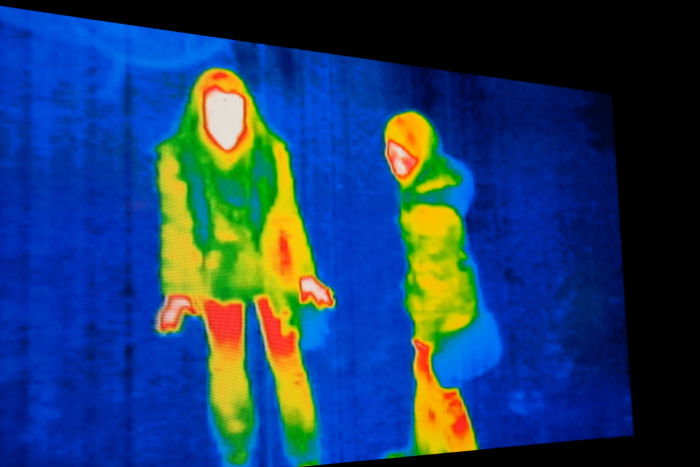
What Are the Important Features of a Thermal Camera?
These are the key features to look out for when buying thermal imaging cameras:
- Resolution: Like a normal digital camera, this is how many pixels there are. Pixel count isn’t nearly as crucial as it is in digital photography. You don’t need to see the pattern on your brickwork. You just want to know how warm it is. So the best thermal cameras have better resolution than cheaper ones. It just might not be as crucial as we are used to.
- Sensitivity Range: This is the scope of max and minimum temperatures the thermal cameras can “see.” Our review’s cheapest camera is very sensitive. The PerfectPrime IR202 range is -40 F to 752 F (-40 to 400 C). The extreme ranges are cold enough for most and hotter than your pizza oven. But it’s not quite hot enough for the fire brigade!
- Thermal Sensitivity: This is the smallest detectable temperature difference between two measurement points. Thermal sensitivity is measured with the cutest measurement unit in science. It is the milli-Kelvin (mK). Again, using our list’s cheapest camera as an example, it has 150 mK sensitivity. That means every pixel can tell the temperature difference between areas—of as little as 0.15 C! The lower the number, the more sensitive the sensor. But 150 mK is way more than sufficient to find where heat is escaping.
- A Visible Light Camera: This helps us see conventional and infrared images. After an illness and eye surgery, Claude Monet could see IR light. But we can’t. So overlaying the IR images on a normal photo helps us see where the hotspots are.
- Style: You either have it, or you don’t! But here, I’m referring to the body that houses the thermal imaging camera. Some camera bodies are like barcode scanners. And others are like small, chunky mobile phones. And speaking of mobile phones, some attach via the USB or Lightning port on the base of your phone.
- Screen Resolution: Does the thermal imaging camera use your phone? Then the screen resolution will be good. Otherwise, check the camera itself so it won’t disappoint.
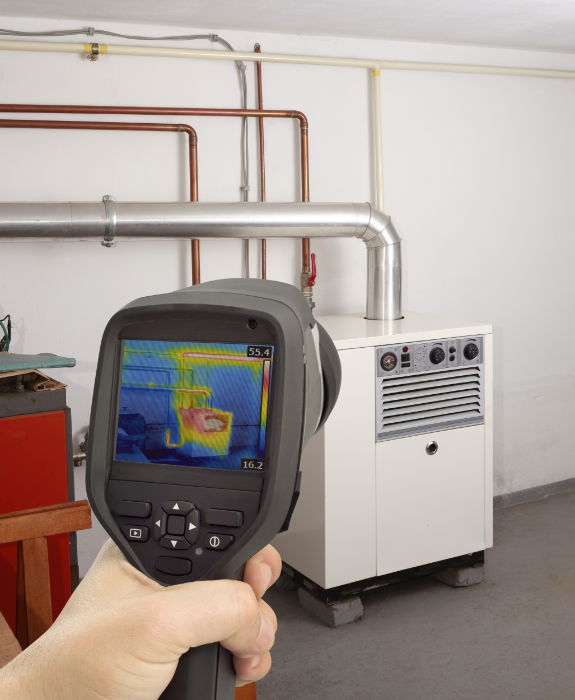
Conclusion: Best Thermal Cameras
The best thermal camera is the PerfectPrime IR202. This is due to its advanced features, easy-to-use design, and affordability. This camera offers a reliable and accurate way to detect temperature differences. And is perfect for both professional and amateur use.
Its USB-C connection allows for quick transfer of data. And its lightweight design makes it easy to transport. It’s the best choice for a reliable and accurate thermal camera.
Our Top 3 Choices for The Best Thermal Camera
FLIR ONE Gen 3 Thermal Camera
FLIR ONE Gen 3 Thermal Camera
Shop Offers
×
FLIR ONE Gen 3 Thermal Camera Deals

|
(second hand)
Check Price
|
(second hand)
|
Check Price
|
Buy Now!
|
If you buy a product through one of our referral links we will earn a commission (without costing you anything).
Prices last updated on .
As an Amazon Associate, I earn from qualifying purchases. Product prices and availability are accurate as of the date/time indicated and are subject to change. Any price and availability information displayed on Amazon at the time of purchase will apply to the purchase of this product.
Unavailable
TOPDON TC002 Thermal Imaging Camera
TOPDON TC002 Thermal Imaging Camera
Shop Offers
×
TOPDON TC002 Thermal Imaging Camera Deals

|
(second hand)
Check Price
|
(second hand)
|
Check Price
|
Buy Now!
|
If you buy a product through one of our referral links we will earn a commission (without costing you anything).
Prices last updated on .
As an Amazon Associate, I earn from qualifying purchases. Product prices and availability are accurate as of the date/time indicated and are subject to change. Any price and availability information displayed on Amazon at the time of purchase will apply to the purchase of this product.
Unavailable
FLIR C3-X Thermal Camera
Shop Offers
×
FLIR C3-X Thermal Camera Deals

|
(second hand)
Check Price
|
(second hand)
|
Check Price
|
Buy Now!
|
If you buy a product through one of our referral links we will earn a commission (without costing you anything).
Prices last updated on .
As an Amazon Associate, I earn from qualifying purchases. Product prices and availability are accurate as of the date/time indicated and are subject to change. Any price and availability information displayed on Amazon at the time of purchase will apply to the purchase of this product.
Unavailable



























